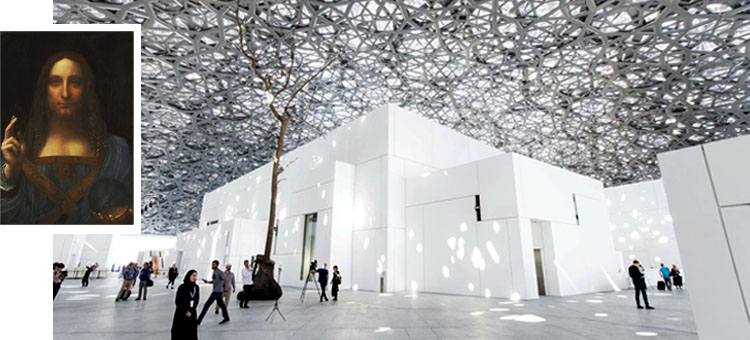Mumbai: Salvator Mundi, a masterpiece by Leonardo da Vinci, will be unveiled to the public at Louvre Abu Dhabi on September 18, 2018. Acquired by the Department of Culture and Tourism, Abu Dhabi (DCT Abu Dhabi) in 2017, Salvator Mundi is one of fewer than 20 known surviving paintings by the Italian Renaissance master, one of history’s greatest and most renowned artists, and is his final work to enter into a cultural institution’s collection.
Mohamed Khalifa Al Mubarak, Chairman, Department of Culture and Tourism, Abu Dhabi, said: “The Salvator Mundihighlights the inclusive nature of Louvre Abu Dhabi’s narrative and Abu Dhabi’s mission to promote a message of acceptance, and openness. It is an opportunity for Abu Dhabi’s residents and visitors from around the world to engage with a rare and iconic work of great cultural significance at Louvre Abu Dhabi.”
“Lost and hidden for so long in private hands, Leonardo Da Vinci’s masterpiece is now our gift to the world. It belongs to all of us, who will have the chance to stand before it, and bear witness to the mastery of one of the most significant artists in living history”.
His innovative breaks from the artistic standards of his day have guided generations of artists since. He is among the most influential artists in history, having left a significant legacy not only in the realm of art but in science as well, each discipline informing his mastery of the other. Today, no name better seems to symbolise the Renaissance age than Leonardo da Vinci.
His Salvator Mundi represents an important chapter in the history of art, and offers a fully-rounded view of his artistic output. It will play a significant role in Louvre Abu Dhabi’s curatorial narrative, representing a critical moment of historical change that illuminates social evolution at that time.
As the ultimate symbol of the Renaissance, da Vinci’s seemingly infinite curiosity was equalled only by his power of invention.
His genius lay in his ability to connect science and anatomy, geology, math, engineering, architecture, theatre, optics, and dozens of other disciplines. In Salvator Mundi, da Vinci’s knowledge of optics is evident in the representation of the orb. It is rendered with beautiful scientific precision, even including the jagged bubbles visible on the bottom right that have the irregular shape of the tiny gaps in crystal that are known as inclusions.
Dating from around 1500, Salvator Mundi is an oil on panel painting, executed onto a walnut panel, depicting a half-length figure of Christ as Saviour of the World, facing the viewer, and dressed in flowing robes of lapis and crimson. The figure holds a crystal orb in his left hand as he raises his right hand in benediction. It is believed to be a contemporary of both La Belle Ferronnière and the Mona Lisa.
Saif Saeed Ghobash, Undersecretary, Department of Culture and Tourism, Abu Dhabi, said: “At more than 500 years old, Salvator Mundi still retains a remarkable presence and the lingering sense of mystery that characterises Leonardo’s finest works. As one of history’s greatest painters, polymaths and thinkers, da Vinci left his stamp on many of the disciplines that have shaped the modern world.”
“He has remained an outstanding cultural icon and as such, his work has an important role to play in Louvre Abu Dhabi’s universal narrative, which encapsulates the history of humanity. With Salvator Mundi on display, we will be able to honour the influential legacy of da Vinci’s creative genius, share this extraordinary artwork with the world, and inspire a new generation of cultural leaders and creative thinkers.”
The rediscovery of Salvator Mundi is one of the most significant artistic findings in recent history, as the first discovery of a painting by Leonardo da Vinci since 1909, when the Benois Madonna, now in the Hermitage, St. Petersburg, was attributed to the artist.
The unveiling of the artwork ahead of its sale at Christie’s New York drew worldwide interest. Throughout the painting’s tour of Hong Kong, London, San Francisco, and New York, over 27,000 people viewed the work, setting a record for the highest ever number of pre-sale viewers for an individual work of art, according to Christie’s.
Painted more than 500 years ago (c. 1490 – 1515), Salvator Mundi may have been created for the French royal family before being brought to England by Queen Henrietta Maria when she married Charles I.
After it’s unveiling at the Louvre Abu Dhabi in September, the Salvator Mundi is scheduled to be loaned to Musée du Louvre in Paris, where it will form part of the Leonardo da Vinci exhibition, which will run from October 24, 2019 to February 24, 2020. Salvator Mundi is planned to return to Abu Dhabi after the exhibition, and will be on display again at the Louvre Abu Dhabi.





